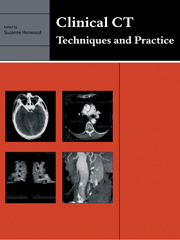CHAPTER 2 - The Head
Published online by Cambridge University Press: 16 March 2010
Summary
Patient preparation
A simple generalised instruction leaflet is included as part of the appointment letter from the present writer's department. It includes a simple line drawing of a ‘typical’ CT scanner, showing that it is not enclosed or tunnel-like. There is a statement that the patient may be given an injection into one of their arm veins, and a possible waiting time of 30 minutes is also mentioned which helps the unit to cope with delays caused by emergencies.
Each patient is given an explanation of the procedure for their individual scan on being brought into the scan room. It is important to explain the need for the head rest and any immobilising straps and pads. Ensure that the patient is comfortable; use knee supports and pillows if necessary.
In the present writer's department apprehensive patients may be shown around the scanner when they come to make their appointment. This can be particularly helpful with children.
The normal CT brain scan
There is no such thing as a ‘normal’ brain scan; only one that is considered as normal for the age and sex of the particular subject. Figures 2.1–2.10 are scans from of a 50-year-old female whose small degree of cerebral atrophy, compatible with age, is an aid to demonstration of normal anatomy.
In the writer's unit, the preferred method of scanning is to obtain images closely compatible with those from the magnetic resonance (MR) imaging department.
- Type
- Chapter
- Information
- Clinical CTTechniques and Practice, pp. 7 - 32Publisher: Cambridge University PressPrint publication year: 1999

